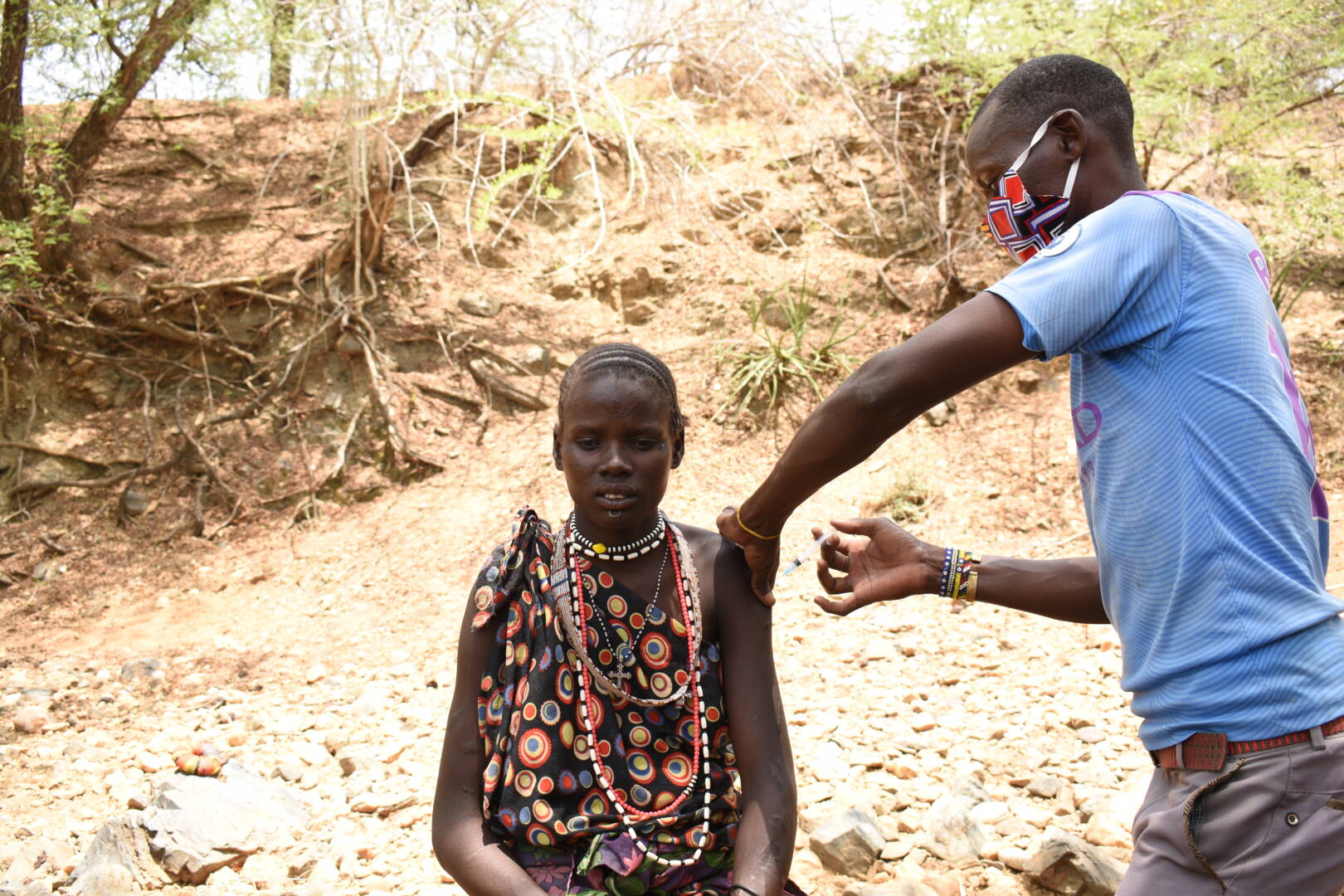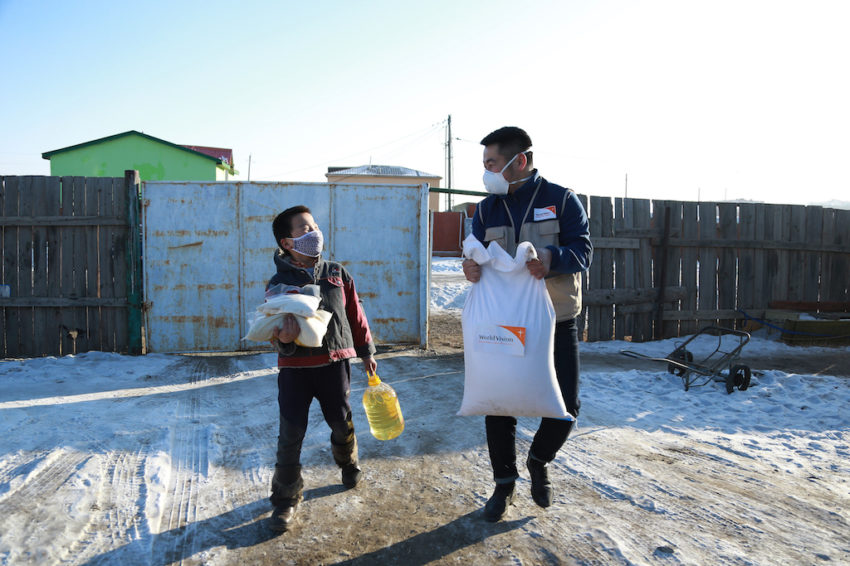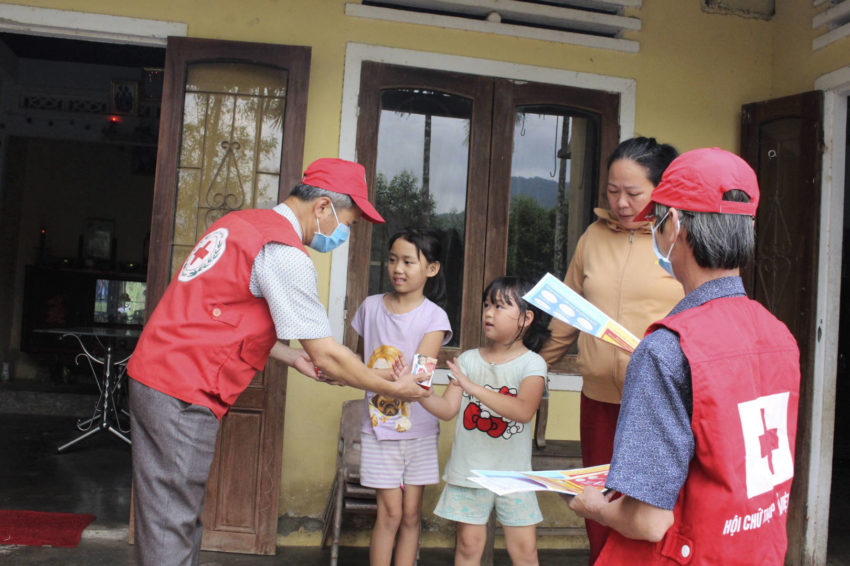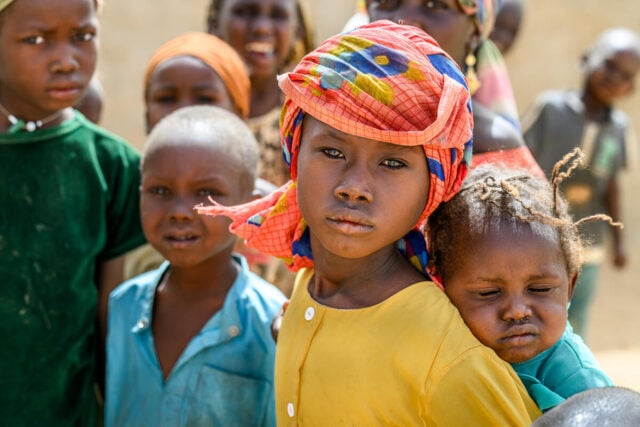The emergence of the coronavirus pandemic in late 2019, and its respiratory disease, COVID-19, has left an indelible mark on the world. Beyond its immediate health implications, the pandemic poses a threat to progress made in reducing global poverty and income inequalities. Particularly concerning is the potential long-term impact on the next generation of children.
COVID-19 pandemic: Facts, FAQs, and how to help
- Fast facts: Coronavirus and COVID-19
- What do I need to know about the coronavirus and COVID-19?
- Why is the coronavirus worse than the flu?
- How did World Vision respond to the COVID-19 pandemic in the U.S.?
- What was World Vision’s response to the coronavirus pandemic worldwide?
- How many people has World Vision supported since the start of the pandemic?
- What has been the impact of the COVID-19 pandemic on children?
- How has the pandemic affected sponsored children?
- How can I help people made more vulnerable by emergencies like the pandemic?
- COVID-19 timeline
Fast facts: Coronavirus and COVID-19
- As of mid-January 2024, over 774 million cases and 7 million deaths have been recorded worldwide since December 2019.
- In the most recent reporting, the United States led the world with nearly 104 million cumulative cases and more than 1.1 million deaths.
- The coronavirus, SARS-CoV-2, was first identified on December 31, 2019.
- COVID-19 is the first pandemic since the 2009 swine flu (H1N1) pandemic, which mostly affected children and young adults.
- In less than two years during the pandemic, 100 million more children fell into poverty, representing a 10% increase since 2019. An estimated 356 million children now live in extreme poverty.
- Up to 10 million more girls are at risk of becoming child brides due to the COVID-19 pandemic.

What do I need to know about the coronavirus and COVID-19?
Coronaviruses are a family of viruses, some of which can infect people and animals, named for crownlike spikes on their surfaces. COVID-19 is an infectious respiratory disease caused by the coronavirus. It spreads primarily by person-to-person contact through respiratory droplets that become airborne when an infected person coughs, sneezes, or speaks.
COVID-19 symptoms: These include respiratory illness with fever, cough, and difficulty breathing. Sometimes people experience chills and shaking, muscle pain, headache, sore throat, or a loss of sense of taste or smell. In severe cases, COVID-19 can cause pneumonia and severe acute respiratory syndrome. People with chronic health conditions and the elderly are more likely than others to have a life-threatening case of the disease.
Variants: New variants of SARS-CoV-2, the virus that causes COVID-19, will continue to evolve as they spread and replicate. Some disappear. The CDC tracks and continues to monitor variants. According to the CDC, the omicron variant and its versions likely spread more easily than the original COVID-19 virus and have become the dominant strains in the U.S. Studies suggest that the currently authorized vaccines provide better protection than going without the safeguards.
Learn more from the CDC’s latest update on COVID-19 vaccines and boosters.
Why is the coronavirus worse than the flu?
Although the seasonal flu spreads globally like the coronavirus, the mortality rate for the flu is much lower, and more people have immunity (either naturally or via a flu vaccine). While the flu and COVID-19 are contagious respiratory illnesses, they’re caused by different viruses. The flu is caused by infection with an influenza virus, while the novel coronavirus, SARS-CoV-2, causes COVID-19, a more infectious and often more serious illness, according to the CDC.
How did World Vision respond to the COVID-19 pandemic in the U.S.?
World Vision supplied Family Emergency Kits to vulnerable families from strategic locations throughout the U.S., including Chicago, Los Angeles, New York City, and Seattle. Each kit includes nutritious food for a family of five for a week, as well as hand sanitizer, disinfectant wipes, first-aid antiseptic, paper products, and children’s games and school supplies.
Since March 2020, the onset of the pandemic, we distributed 87,600 Family Emergency Kits, serving more than 328,700 children and adults through our church partners as of February 1, 2024. In partnership with the USDA Farmers to Families Food Box program, we distributed more than 3.6 million Fresh Food Boxes to nearly 14.3 million people across the U.S. through a network of over 1,300 churches between May 2020 and May 2021.
World Vision also distributed more than 3 million items of personal protective equipment to healthcare systems, first responders, and schools across the U.S., including a distribution to the Navajo Nation.
What was World Vision’s response to the coronavirus pandemic worldwide?
World Vision prioritized our COVID-19 response in every country where we work. Our global response focused on four main objectives, with programs that were adapted based on context and local need: scaling up preventive measures to slow the spread, strengthening healthcare systems and workers, supporting children impacted by the effects of the pandemic, and collaborating and advocating with partners to ensure that vulnerable children got the care they need.
We served vulnerable populations in countries where the health systems and monitoring were weak; where people have been suffering from diseases common among impoverished populations, such as malaria, tuberculosis, pneumonia, HIV and AIDS, and Ebola; or where severe malnutrition compromised immune systems.
How many people has World Vision supported since the start of the pandemic?
World Vision supported more than 99 million people globally to stay safe during the pandemic with supplies and information about protecting themselves from COVID-19, including handwashing, social distancing, mask usage, hygiene practices, and vaccines. As of September 2022, marking the end of our program’s reporting, here are response highlights:
- Partnered with more than 207,614 faith leaders to ensure vulnerable families have information on COVID-19 prevention and care and vaccines.
- Distributed more than 12.8 million supplies, including handwashing materials, hygiene kits, and cleaning kits, to keep communities safe.
- Established or maintained nearly 297,000 facilities, like community handwashing stations, school toilets, household latrines with handwashing facilities, clean drinking water systems, and community drainage systems, to limit the spread of COVID-19.
- Reached more than 54 million people with health interventions, including preventative behavior and vaccine messaging, safe quarantine and/or isolation spaces, and transportation support and services.
- Trained 291,430 community health workers in COVID-19 prevention measures, including vaccines.
- Aided more than 5.2 million people with educational materials, support, or training so children could keep learning during pandemic-related school closures.
- Helped more than 13 million people in 64 countries with cash and vouchers or food assistance.
- Supported over 1.9 million children with child protection activities.
- Assisted more than 5 million people with psychosocial support or age-specific health information, education, and communication materials.
- Equipped people and communities to recover and thrive during COVID-19 through VisionFund’s microfinancing, recovery loans, and savings groups.
Even as our commitment focused on responding to immediate needs, helping people restore livelihoods and build back required guaranteed access to coronavirus vaccines, tests, and treatments for everyone who needed them globally.
Vaccines play a critical role for the most vulnerable
In 2022 alone, World Vision reached more than 10.5 million people, including 4.2 million children, with ongoing support for vaccine programs and interventions to reduce the pandemic’s indirect impacts on the most vulnerable people.
Globally and through our local staff, World Vision has extensive experience confronting pandemics, supporting vaccination programs, and improving child health. We worked alongside our partners to implement immunization campaigns and ensure communities understood the benefits of a COVID-19 vaccination. The availability of COVID-19 vaccines for vulnerable people globally will continue to enormously benefit the hundreds of millions of children whom the pandemic has negatively impacted by giving them a lifeline to return to their childhoods. Vaccines are a game changer for children, as they allow kids to resume school and families to recover their livelihoods.
What has been the impact of the COVID-19 pandemic on children?
The pandemic touched virtually all aspects of daily life and thrust children everywhere into a new world of uncertainty, with the loss of loved ones, shuttered schools, and isolation from friends, family members, and community. For many children in developing countries, it’s also increased poverty, hunger, and the risk of child marriage, child labor, gender-based violence, and exploitation.
- An estimated 5.2 million children worldwide have lost a primary or secondary caregiver due to COVID-19.
- In 2021, experts estimated that an additional 8.9 million children will have engaged in child labor by the end of 2022 due to rising poverty driven by the COVID-19 pandemic.
- Following abrupt drops in household incomes, disruptions to the supply of affordable, nutritious foods, and interruptions to health, nutrition, and social protection services, up to 15% more children suffered from wasting in 2020 compared with projections for 2020 without COVID-19.
The pandemic also ushered in new challenges for children’s mental health or intensified pre-existing mental health issues.
World Vision, in partnership with War Child, examined the impact of COVID-19 on the mental and psychosocial well-being of children living in conflict-affected countries, including Colombia, the Democratic Republic of Congo, Jordan, Lebanon, and South Sudan. According to the 2021 study, the number of refugee children who said they needed mental health support had more than tripled because of COVID-19.
How has the pandemic affected sponsored children?
World Vision worked diligently to help protect children from the indirect effects of the COVID-19 disease, like hunger and extreme poverty. Through our child sponsorship programs, we:
-
- Assessed local situations and responded in the most appropriate ways
- Trained staff, community volunteers, and partners on the prevention of COVID-19 and access of care and treatment
- Worked with local health authorities and community organizations to spread accurate information about COVID-19, including the importance of vaccination when available, to families and communities
How can I help people made more vulnerable by emergencies like the pandemic?
You can help bring hope to people who have been made more vulnerable by crises like the pandemic.
COVID-19 timeline
December 2019
- December 31: In Wuhan, China, reports surface of people with pneumonia due to an unknown cause. Between December 31 and January 3, national authorities in China report 44 cases to the World Health Organization (WHO).
January 2020
- January 9: The first confirmed death from the outbreak occurs.
- January 11: The National Health Commission in China informs the WHO that the outbreak is linked to exposure to the seafood and live animal market in Wuhan. Meanwhile, Chinese authorities identify a novel (new) coronavirus.
- January 12: Chinese health officials share the genetic sequence of the novel coronavirus for countries to use in developing specific diagnostic kits.
- January 21: The WHO confirms 314 cases of the new coronavirus, 309 of which are in China. Other countries reporting cases include Thailand, Japan, and the Republic of Korea. The CDC confirms the first case in the United States — a person in Washington state who returned from Wuhan on January 15. The death toll rises to six. Many people affected have underlying health issues, according to Reuters.
- January 24: Reported cases around the world increase to 846, with 830 in China. Singapore and Viet Nam report their first cases, and a second case is identified in the U.S. — a person who lives in Illinois and recently visited Wuhan. The death toll increases to 25.
- January 25: The WHO confirms 1,320 cases globally. Australia, Nepal, and France report their first cases. A third U.S. case is identified in Orange County, California — a person who had recently traveled to Wuhan. Forty-one people have died so far, all in China.
- January 28: Global cases jump to 4,593, with 4,537 in China. The death toll increases to 106, and three more countries — Cambodia, Sri Lanka, and Germany — report cases.
- An airliner with about 210 U.S. citizens, mostly consulate personnel and their families, leave Wuhan for the United States. CDC officials recommend avoiding all travel to China and expand airport health screenings to 20 U.S. locations.
- Scientists in Australia become the first to recreate the new coronavirus outside of China.
- January 30: The global case total jumps to 7,818, with China accounting for 7,736. Outside of China, 82 cases have been identified in 18 different countries. The WHO reports cases in Malaysia, the Philippines, India, and Finland. Italian Prime Minister Giuseppe Conte confirms Italy has its first two cases during a press conference.
- The CDC confirms the first human-to-human transmission in the United States.
- U.S. President Donald J. Trump announces the formation of a coronavirus task force to lead America’s response to the outbreak.
- The WHO emergency committee makes a nearly unanimous decision to declare a public health emergency of international concern.
February 2020
- February 11: The WHO names the illness COVID-19, based on its origin in 2019 and the coronavirus that causes it.
- February 14: A Chinese tourist who tested positive for COVID-19 dies in France, becoming the first person to die from the epidemic in Europe. The same day, Egyptian officials announce the country’s first case of COVID-19, according to a joint statement by Egypt’s Ministry of Health and the WHO. This is the first confirmed case in Africa.
March 2020
- March 11: The WHO declares COVID-19 a pandemic.
- March 12: The global case total passes 128,000 people, with the death toll now at over 4,700 people.
- Travel bans cascade around the globe.
- Wall Street suffers its worst day since 1987 as virus fears spread.
- Events across the U.S. are canceled or postponed. Many universities and schools temporarily close or announce a move to online learning. Professional and collegiate sports seasons are also affected, including the NBA, NHL, MLB, MLS, and the NCAA, which cancels the annual March Madness basketball tournament.
- March 16: Coronavirus vaccine testing begins in the U.S. Even if the research goes well, a vaccine wouldn’t be available for widespread use for 12 to 18 months, says Dr. Anthony Fauci of the U.S. National Institutes of Health.
- March 17: Coronavirus cases have now been identified in all 50 U.S. states.
- March 26: The overall number of cases passes 550,000 worldwide, with more than 175 countries reportedly affected. The U.S. now leads the world in the number of confirmed cases.
April 2020
- April 2: Cases worldwide top 1 million. More than 200,000 people in the U.S. have been infected.
- April 11: Cases in the U.S. surpass 500,000.
- April 27: Cases worldwide reach 3 million, with 185 countries now affected by the pandemic.
May 2020
- May 9: Cases worldwide top 4 million.
July 2020
- July 8: Globally, the coronavirus has infected more than 11.8 million. Cases in the U.S. surpass 3 million.
- July 14: The CDC recommends Americans wear masks to prevent the spread of COVID-19.
- July 22: Global cases exceed 15 million.
- July 27: Phase III clinical trials for a COVID-19 vaccine, developed by Moderna, begin in the United States.
August 2020
- August 1: Mexico’s COVID-19 death toll becomes the third highest in the world. Mississippi records the highest COVID-19 positivity rate in the nation.
- August 6: Africa’s cases surpass 1 million, with South Africa accounting for more than half.
- August 10: Moderna and U.S. federal officials reach a deal to supply the United States with 100 million doses of Moderna’s experimental COVID-19 vaccine.
- August 13: The WHO reports that the COVID-19 pandemic is costing the global economy over $375 billion per month, citing International Monetary Fund research.
September 2020
- September 29: Global deaths surpass 1 million. Deaths from coronavirus-related illnesses have doubled in just three months, led by fatalities in the U.S., Brazil, and India. The NFL reports its first COVID-19 outbreak.
- September 30: The WHO announces nearly $1 billion to fight COVID-19 and to make sure poor countries receive treatments and vaccines against the disease.
October 2020
- October 1: U.S. President Donald J. Trump and first lady Melania Trump test positive for COVID-19.
- October 8: The White House COVID-19 outbreak reaches at least 34 people.
- October 28: The U.S. announces it will provide no-cost access to the COVID-19 vaccine, once available, for all Americans.
- October 29: WHO officials announce that Europe is again the epicenter of the pandemic.
- October 30: Cases in the U.S. surpass 9 million.
November 2020
- November 4: The United States passes 100,000 new daily COVID-19 cases for the first time.
- November 17: New unemployment claims in the U.S. fall below 1 million for the first time since March.
December 2020
- December 11: The U.S. Food and Drug Administration (FDA) issues the first emergency use authorization for a COVID-19 vaccine to Pfizer-BioNTech.
- December 14: The death toll in the United States surpasses 300,000. COVID-19 moves ahead of heart disease as the leading cause of death in the nation.
- December 18: The FDA authorizes Moderna’s COVID-19 vaccine for emergency use in the U.S.
- December 20: Several European countries impose travel restrictions after new coronavirus variants are identified there. The new variants begin to emerge in the U.S., with the first case reported in late December.
- December 21: The Pfizer-BioNTech vaccine is approved by the European Union.
January 2021
- January 14: A WHO team of scientists arrive in Wuhan, as China ramps up efforts to contain a resurgence of COVID-19 infections in China’s northeast.
- January 19: The U.S. surpasses 400,000 coronavirus–related deaths.
February 2021
- February 22: The U.S. passes 500,000 coronavirus–related deaths.
- February 26: The United States administers 70.5 million COVID-19 vaccines.
- February 27: The FDA authorizes the Johnson & Johnson vaccine for emergency use in the U.S.
March 2021
- March 11: Brazil’s intensive care units surpass 90% capacity in 15 capitals as the pandemic flares up. Researchers in Brazil identify two cases of simultaneous infection with two different coronavirus variants.
- March 17: The European Union unveils its plans for vaccine passports, while the United Kingdom considers a vaccine passport option for summer travel.
April 2021
- April 23: The FDA announces its first full approval of a COVID-19 vaccine, produced by Pfizer-BioNTech.
May 2021
- May 7: India is experiencing a deadly second wave of COVID-19 infections. The world’s second-most populous country records 414,188 new cases in one day — a record high.
- May 10: The FDA approves Pfizer’s COVID-19 vaccination for children as young as 12.
- May 12: The Red Cross warns that cases are exploding across Asia, with more than 5.9 million new confirmed infections in the past two weeks. India’s death toll surpasses 250,000.
- May 13: The CDC announces that fully vaccinated Americans do not need to wear a mask indoors or outdoors or follow physical distancing guidelines. Guidelines will still apply for travel and public transit.
June 2021
- June 10: Over 172 million people in the U.S. have received at least one dose of the COVID-19 vaccine, according to the CDC. More than 873 million people worldwide have received at least one dose, according to the WHO.
- June 19: Brazil reports a total of more than 500,000 deaths from COVID-19, the world’s second-highest confirmed death toll.
July 2021
- July 15: Coronavirus–related deaths rise sharply in Africa, where countries face shortages in oxygen and intensive care beds. The number of deaths rise more than 40% this week, reaching 6,273 — nearly 1,900 more than the week before.
- July 17: The first case of COVID-19 is detected in Tokyo’s Olympic village.
- July 29: President Joe Biden calls on school districts to host pop-up clinics in order to vaccinate more children 12 and older against COVID-19 as worries intensify that the upcoming school year will be interrupted by the delta variant. The CDC describes the delta variant as being as transmissible as chickenpox.
August 2021
- August 2: The United States reaches a 70% vaccination rate.
- August 5: California becomes the first U.S. state to mandate COVID-19 vaccinations for all health workers.
- August 23: The FDA grants full approval to the Pfizer-BioNTech vaccine.
September 2021
- September 22: The FDA authorizes Pfizer-BioNTech booster shots for Americans over 65 or who are at risk of severe COVID-19 complications.
October 2021
- October 20: The FDA recommends a Moderna booster for people 65 and older and the immunocompromised.
- October 29: The FDA approves the Pfizer-BioNTech COVID-19 vaccine for emergency use in children ages 5 to 11.
November 2021
- November 1: The global death toll surpasses 5 million.
- November 2: The CDC recommends pediatric COVID-19 vaccines for children 5 to 11.
- November 19: The FDA authorizes booster shots of both Pfizer-BioNTech and Moderna vaccines for everyone 18 and older.
- November 26: WHO officials classify omicron as a SARS-CoV-2 variant of concern.
December 2021
- December 27: The CDC shortens the recommended COVID-19 isolation period to five days.
January 2022
- January 3: The FDA authorizes the Pfizer-BioNTech vaccine booster shots for children 12 to 15.
- January 5: The United States joins Brazil, Hungary, Israel, Italy, and the Philippines in reporting cases of “flurona,” or COVID-19 and Influenza coinfection.
February 2022
- February 15: The Pan-American Health Organization delivers 100 million vaccines to Latin America and the Caribbean via COVAX.
- February 18: The U.S. announces increased vaccine assistance to 11 African countries through its new Initiative for Global Vaccine Access.
March 2022
- March 20: The CDC reports a surge in U.S. hospitalizations of young children with COVID-19 during omicron wave.
- March 24: The WHO identifies the omicron BA.2 “stealth variant” as the dominant strain of omicron worldwide, making up a majority of cases.
April 2022
- April 13: The CDC extends mask requirements, set to expire April 18, to allow more time to study omicron subvariants circulating in the U.S.
- April 18: A federal judge in Florida voids the federal government’s nationwide mask order for public transit, commercial flights, and transportation hubs such as airports and train stations.
July 2022
- July 13: Novavax approved in the U.S. for use in people who haven’t yet been vaccinated.
- July 21: President Biden tests positive for COVID-19 and experiences mild symptoms.
September 2022
- September 14: The World Health Organization Director-General Tedros Adhanom Ghebreyesus says, “We have never been in a better position to end the pandemic,” but warned that if the world doesn’t take the opportunity now, there’s still a risk of more variants, deaths, disruption, and uncertainty.
2023
- January 25: The government of North Korea imposes a five-day lockdown on Pyongyang, its capital city, after a spike in respiratory illness..
- January 30: President Biden informs Congress that his administration will not seek a renewal of the public health emergency for COVID-19 after it expires on May 11, 2023.
- May 5: WHO officials announce the end of the emergency phase of COVID-19.
- July 6: China reports a rise in COVID-19 deaths in June following the lift of most containment regulations.
- July 31: The U.S. Department of Health and Human Services establishes the Office of Long COVID Research and Practice to lead the national response to Long COVID and help coordinate the launch of Long COVID-related clinical trials.
Sevil Omer, Heather Klinger, and Kristy J. O’Hara-Glaspie of World Vision’s U.S. staff contributed to this article.











